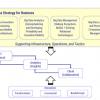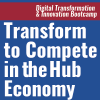Business Transformation Requires Transformational Leaders
Leadership and teaming skills are front and center in times of rapid change. Meet today’s constant disruption head on with expert guidance in leadership, business strategy, transformation, and innovation. Whether the disruption du jour is a digitally-driven upending of traditional business models, the pandemic-driven end to business as usual, or the change-driven challenge of staffing that meets your transformation plans — you’ll be prepared with cutting edge techniques and expert knowledge that enable strategic leadership.
Subscribe to Arthur D. Little's Culture & Leadership Newsletter
Insight
There are several key challenges that prevent companies from pursuing innovation effectively by using emerging and disruptive technology trends. In this Advisor, we explore these challenges and offer some key strategic questions for innovation planning.
Managing Systemic Risks in a Fair and Transparent Cloud Market
As we discuss in this Executive Update, the risks in the infrastructure as a service (IaaS) market must be mitigated to avoid market failure and deliver a stable cloud computing market.
This Executive Update continues from where I left off in Part V by examining more domains and industries where blockchain technology will have the most significant impact.
This Advisor provides a framework for scaling up innovation so that new ideas are not presented by just one team or segment of the organization, they are accumulated from every nook and corner.
Businesses judge innovation in terms of the value it provides in either handling existing problems or tapping into new opportunities. A frameork such as BDFAB is most helpful in channeling an organization’s innovation efforts.
Leading Enterprise Agility
In his prelude to the Digital Technology &Innovation Bootcamp, Cutter Consortium Senior Consultant Don MacIntyre presented how you and other leaders in your organization can leverage agile practices to drive value in your businesses.
Cutter’s Digital Transformation Bootcamp is designed to get a team thinking analytically and strategically about how its industry is changing. The Bootcamp immerses an executive team in the challenges and opportunities digital transformation presents so that they can walk away with new ideas and strategies that have been vetted by other smart business leaders.
The Innovator’s Imperative
As we explore in this Executive Report, it is imperative to stay ahead of the competition by building the capabilities and strategic flexibility to disrupt oneself and the market by adopting the emerging and disruptive technologies most relevant to your current and future business models as quickly as possible — the idea being to try soon, fail fast to learn fast rather than wait to be disrupted.















